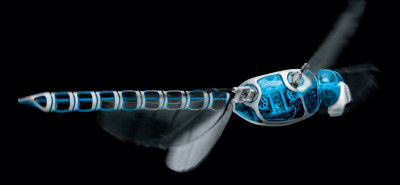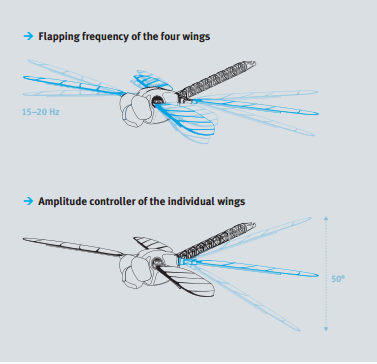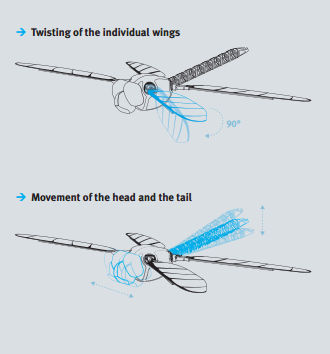| Festo's Dragonfly |
| Written by Harry Fairhead | |||
| Saturday, 30 March 2013 | |||
|
Festo has a reputation for building amazing robotics platforms that are based on nature and the latest, a dragonfly, has to be seen to be believed. It is a masterpiece of engineering and a showcase for microprocessor-based control. If you have ever watched a dragonfly, or any four-winged insect, fly then you might have shared my concern that it would only take a small error for the whole thing to come crashing down. Four flapping wings seems like a complex way to get into the air compared to, say, a fixed wing plane or a helicopter rotor, but watch the video Festo has produced and you might agree that it is worth the effort. Called the BionicOpter, it flies like a dragonfly:
It has a wingspan of 70cm and a length of 48cm and weight a remarkable 175gms. The wings are made of carbonfibre and foil. Inside the body there is a battery, nine servos and an ARM microcontroller.
The wings are controlled by the microcontroller and the four wings can generate thrust in any direction without the need to tilt the body. The microcontroller does all of the calculations needed to drive the dragonfly in any specified direction and speed by changing the wing beat frequency, amplitude and twist:
Overall there are 13 degrees of freedom in flight. A single motor powers all of the wings at a common frequency of between 15 and 20Hz. Each wing has its own swivel control and the amplitude can be changed by the range of movement. This accounts for nine degrees of freedom the last four are build into the head and tail which use memory wire to move the head horizontally and the tail vertically. All of the degrees of freedom are combined to all the BionicOpter to hover, fly or glide and the user simply gives it instructions via a smart phone without having to worry about the detail.
It is easy to be captivated by the engineering to overlook the complexity of the control system. Being able to use such sophisticated lifting surfaces in a closed loop system opens up many possibilities for other flying machines that "swim through the air". What are the practical uses? What payloads could it carry? Does it matter? If it ever hits the shops it will sell in large numbers.
More Informationhttp://www.festo.com/en/bionicopter Related ArticlesAir muscles power humanoid robot To be informed about new articles on I Programmer, sign up for our weekly newsletter, subscribe to the RSS feed and follow us on Twitter, Facebook or Linkedin.
Comments
or email your comment to: comments@i-programmer.info
|
|||
| Last Updated ( Saturday, 09 March 2019 ) |





